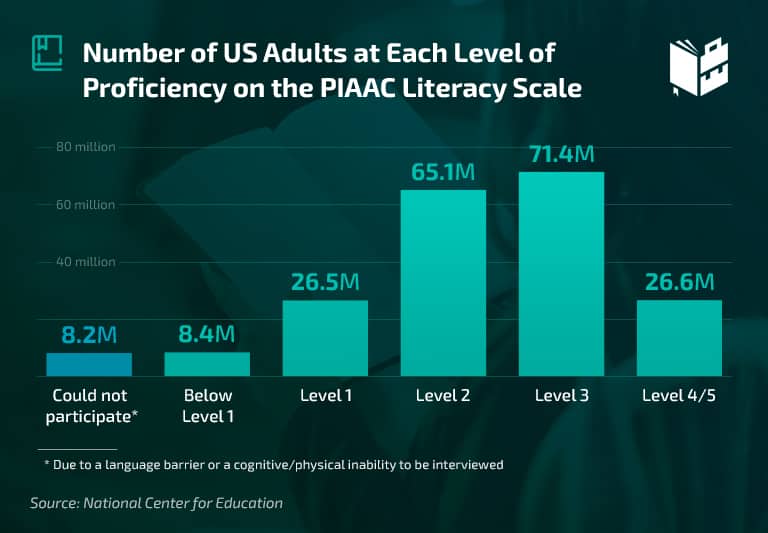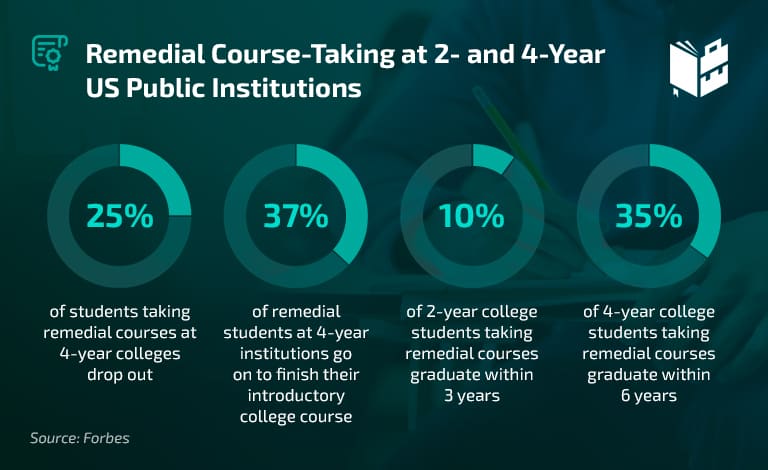There’s no need to beat around the bush — college remediation rates in the US are disappointing. Before going through the facts and statistics listed below, readers should know that 75% of students required to take remedial college classes fail to graduate.
College remediation has become so prominent that it’s no longer regarded as an impolite topic to discuss. Every college student in America has either been in the program as a freshman or knows multiple people enrolled in a college.
The statistics listed below show the numbers related to remediation while answering some of the key questions associated with this topic.
Remediation in Higher Education — Editor’s Choice
- There are around 43 million illiterate American adults.
- A quarter of college freshmen enroll in remedial classes during their first year at college.
- Nearly 30% of African-American students require remedial education in California community colleges.
- Around 80% of California community college students attend remediation courses.
- A quarter of four-year students taking remedial courses drop out.
- Less than 10% of students who take remedial classes graduate on time.
National College Remediation Rates
1. Approximately 43 million American adults can’t read.
(National Center for Education, World Atlas)
According to the latest PIAAC study of adults aged 16–65, 8.4 million Americans are below the basic literacy level, and 26.5 million people can be placed in the basic level reading group. This makes the US 125th on the list of countries by literacy rate.
Finland, Norway, Slovenia, Tajikistan, Barbados, Uzbekistan, and 20 other countries share the first spot on this list, with the literacy rate rounding up to 100%.

2. A quarter of college freshmen enroll in remedial programs during their first year.
(Community College Review)
Unfortunately, the latest developmental education statistics show that a quarter of high school graduates who start a community college take one or more remedial cases in their first year. This represents a huge issue and shows how flawed the high school system is, especially in public schools. The number of students who graduate high school without reaching a satisfactory level of literacy or mathematics is simply staggering.
3. Remedial education costs students $1.3 billion per year overall.
(Center for American Progress)
Regarding developmental education, statistics show that remedial education costs between $400 million and $500 million per year. Moreover, these costs are not equally divided. Percentages of low-income, Hispanic and Black students who enter remedial education are significantly higher than that of their affluent or white peers.
College Remediation Rates by State
4. Nearly 30% of African-American students require remedial education in California community colleges.
(Inside Higher Ed)
Unfortunately, remedial education is even more pronounced among students of color. In fact, African American students make up almost a third of the students requiring remediation courses. Meanwhile, 24% of all Latinx students and 20% of White students enroll in remedial classes.
5. More first-year students passed introductory courses at college after Florida eliminated remedial courses in 2013.
(Inside Higher Ed)
College remediation rates in the state of Florida were a cause for concern. That’s why the state decided to introduce gateway courses that count toward college credits instead of remedial classes. Two-year colleges were also legally obligated to substitute remedial courses with credit-bearing ones.
It seems that the move worked, as 6% more first-year students were able to pass English Composition, Intermediate Algebra, and Gateway Math six years later, in 2019.
6. Michigan’s poorest districts have a remediation rate more than 2.5 times higher than the wealthiest districts.
(The Education Trust)
The college remediation rates by state show that the remediation rate in Michigan’s poorest districts is 39.1%. This number is far above the statewide remediation rate (24.8%). It’s also significantly lower in the state’s wealthiest districts — only 15.2%.
The latest findings suggest that nearly four in 10 students are enrolled in a college remediation course in districts with the highest concentration of students of color. This trend happens across the state, in both urban and rural areas.
7. Approximately 80% of California community college students are placed into remediation.
(PPIC)
In California, the community college remediation rates are drastically different for various public schools in the state. For California State University, the percentage is around 30%, while fewer than 10% of new students go into remediation at the University of California.
8. 25.6% of first-time Ohio students older than 25 enrolled in a remedial course in 2020.
(Ohio Department of Higher Education)
The latest accessible annual college remediation rates by state tell us Ohio had 7,892 students older than 25 who enrolled in fall 2020. Moreover, Ohio’s colleges and universities have seen a decline in remediation rates for all age groups.
Namely, more than a quarter of first-time students over 25 took remedial courses in 2020. In addition, around 30.2% of students aged 22–25 and 24.3% of those younger than 22 who enrolled for the first time also attended remedial classes.
Remedial Coursetaking at US Public 2- and 4-Year Institutions: Scope, Experiences, and Outcomes
9. California’s AB 705 is responsible for a 58% increase in first-time English speakers enrolling in college between 2015 and 2020.
(PPIC)
California’s AB 705 came into effect on January 1, 2018. The regulation aims at abolishing remediation programs or improving their value to ensure that colleges don’t delay the student’s academic progress with unnecessary remedial education in college.
The onus is now on colleges to prove that the student will fail their courses without remedial training and to ensure that their remediation programs add real value for their students.
According to the latest available community college statistics, AB 705 has enabled equal education access to students of all colors in just a few years. The number of first-time English students enrolling in college increased from 38% in 2015 to 96% in 2020, thanks to AB 705.
If current trends in developmental education hold true, mandatory remedial courses will also fall away over time in other states.
10. Between 2015 and 2019, the number of students of color completing their transfer-level English and Math courses increased by 250%–300%.
(RP Group)
Around 2.5 to 3 times as many Black and Latinx students completed their transfer-level English and Math courses in 2019 as opposed to 2015. This statistic indicates that either the remedial courses were not well-thought-out or that they were unnecessary in the first place.
11. 25% of four-year students taking remedial courses drop out.
(Forbes)
In the US, college students placed in remedial courses struggle to achieve academic success. As college remediation rates show, one-fourth of four-year school attendees drop out of the remedial program, while 40% of two-year college students decide to do the same.
On the other hand, only 37% of remedial students at four-year institutions and 23% of those at two-year colleges go on to finish their introductory college courses.
12. Just 10% of two-year college students taking remedial courses graduate within three years.
(Forbes)
Only one in 10 students starting at a two-year college and attending a remedial program graduates within three years. In addition, the attendance data on remedial math and remedial English in college shows that the situation is slightly brighter for those in four-year institutions — 35% of them graduate within six years.

13. 19% of community college remedial students in California transfer to a four-year college within four years.
(PPIC)
For a further 28% of students, the journey takes an additional two years. Success rates drop off significantly after that. Protracting their studies a little may prove useful for remedial students.
However, the longer it takes, the greater the chance that the course material will change and the higher the college tuition fees. Maybe it’s time to look at the remediation rates definition and incorporate more time factors into it.
14. Students in two-year colleges taking writing remediation classes are 11% more likely to earn their degree within eight years.
(ResearchGate)
Students entering two-year programs are 11% more likely to earn their degree within eight years of leaving high school if they take writing remediation classes. Those that take two or more math classes, however, are 3% less likely to complete their degree.
The difference in the difficulty and workloads of the two subjects could account for this discrepancy.
15. On-time completion rates for students taking remedial classes are less than 10%.
(Center for American Progress)
College student statistics suggest that remedial education in college increases the students’ degree attainment time. Moreover, the likelihood of completion decreases.
Somewhere between 40% and 60% of first-year college students need remediation in English, math, or both. This means a vast number of students have low chances of finishing college on time. The situation is even worse for low-income and students of color, whose remedial education rates are much higher than that of their white and well-off peers.
16. Between 2015 and 2019, the number of first-time transfers skipping English remediation increased by 137% in California.
(CAL Matters)
California community college remediation rates show that the number of those skipping remedial math increased by 170% during the same time frame. Interviews with applicants highlighted the importance of reducing the need for remedial courses. Lower-income families, in particular, found the cost prohibitive over and above the need for regular school.
Conclusion
College remediation rates in America are certainly a cause for concern. They’re a clear indicator of the socioeconomic divide in the country, and they demonstrate the extent to which this problem needs to be attended to. In addition, the higher education system in the US needs to work together with K–12 schools to ensure that future generations use these courses less.
We should try to prevent remediation classes by evoking interest in students and investing in colleges and universities.